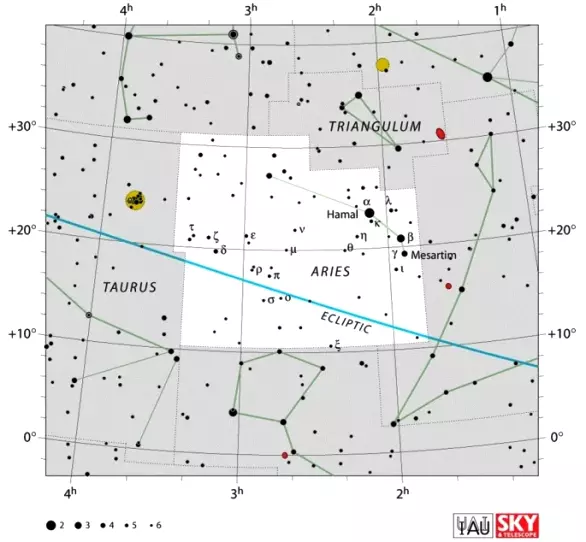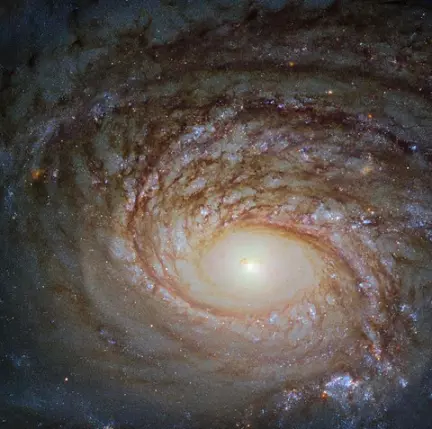Aries constellation is located in the northern hemisphere. Its name means “the ram” in Latin. The symbol for the constellation is ♈ and it represents a ram’s horns.
The constellation Aries is usually associated with the story of the Golden Fleece in Greek mythology. Like other zodiac constellations, Aries was first catalogued by the Greek astronomer Ptolemy in his Almagest in the 2nd century.
Aries contains the bright stars Hamal and Sheratan and is home to several notable deep sky objects, among them the unbarred spiral galaxy NGC 772 and the dwarf irregular galaxy NGC 1156.
Facts, location and map
Aries is the 39th largest constellation in the sky, occupying 441 square degrees. It lies in the first quadrant of the northern hemisphere (NQ1) and can be seen at latitudes between +90° and -60°. The neighboring constellations are Cetus, Perseus, Pisces, Taurus, and Triangulum.
Aries belongs to the Zodiac family of constellations, along with Taurus, Gemini, Cancer, Leo, Virgo, Libra, Scorpius, Sagittarius, Capricornus, Aquarius, and Pisces.
The constellation name Aries is pronounced /ˈɛər(i)iːz/. In English, the constellation is known as the Ram. The genitive form of Aries, used in star names, is Arietis (pronunciation: /əˈraɪ.ɪtɪs/). The three-letter abbreviation, adopted by the International Astronomical Union (IAU) in 1922, is Ari.
The constellation has five stars with known planets and contains no Messier objects. The brightest star in Aries is Hamal, Alpha Arietis. There are several well-known meteor showers connected to this constellation: the May Arietids, Autumn Arietids, Delta Arietids, Epsilon Arietids, Daytime-Arietids, and Aries-Triangulids.
Aries contains six formally named stars. The star names approved by the International Astronomical Union (IAU) are Bharani, Botein, Hamal, Lilii Borea, Mesarthim, and Sheratan.

Aries constellation map by IAU and Sky&Telescope magazine
Myth
Babylonians identified Aries as the agrarian worker, the last stop on the ecliptic. The name of the constellation later changed to Ram, but why Babylonians changed it is uncertain. In the 7th century BC, Neo-Babylonians did a revision of the Babylonian zodiac that placed Alpha Arietis, Hamal, very close to the vernal equinox, which is how Aries came to be so prominent among the zodiac signs in astrology.
In those times, Aries contained the equinox, the point at which the Sun crosses the celestial equator from north to south. Because of precession (slow wobble of Earth’s axis), the vernal equinox is no longer in Aries, but in Pisces. In 130 BC, however, it was located just south of Gamma Arietis (Mesarthim) and was taken to be the starting point of the zodiac.
In Greek myth, Aries is identified with the golden ram that rescued Phrixus and took him to Colchis, where he sacrificed the ram to the gods. The ram’s skin that he placed in a temple was the Golden Fleece, which later appears in the story of Jason and the Argonauts.
Phrixus was the son of a Boeotian king. He had a twin sister, Helle. The children had a stepmother, Ino, who did not like them and wanted to get rid of them. She came up with a plan to put the land of the brink of famine by making sure the wheat crops failed. When a man was sent to consult the Oracle at Delphi, Ino bribed him to lie and say the Oracle asked for the king’s children to be sacrificed if they did not want the people to starve.
Phrixus and Helle were saved by a winged ram with golden wool. The ram was sent by their real mother, the cloud nymph Nephele. It took both children and flew east to Colchis. Only Phrixus survived the journey. Helle fell off the ram and drowned in the Dardanelles. The strait was later renamed to Hellespont, or sea of Helle, in her memory.
Phrixus was welcomed by King Aeëtes of Colchis, to whom he presented the Golden Fleece. In return, the king gave Phrixus his daughter Chalciope’s hand.
Major stars in Aries
Hamal – α Arietis (Alpha Arietis)
Hamal is the brightest star in the constellation Aries and the 48th brightest star in the night sky. It is a K-type orange giant about twice as massive as the Sun, with an apparent magnitude varying between 1.98 and 2.04.
The star is 66 light years distant. Between 2000 and 100 BC, Hamal was located at the vernal equinox, the point that marks the beginning of spring.
The name Hamal means lamb and derives from the Arabic phrase rās al-ħamal, meaning “head of the ram.”
Sheratan – β Arietis (Beta Arietis)
Sheratan, Beta Arietis, is a white main sequence star and a spectroscopic binary, 59.6 light years distant. The companion is suspected to be a G class star. Sheratan has a visual magnitude of 2.64. The name comes from the Arabic phrase aš-šarāţān, which means “the two signs,” and refers to the vernal equinox, which the star marked together with Gamma Arietis a few thousand years ago.
Mesarthim – γ Arietis (Gamma Arietis)
Mesarthim, Gamma Arietis, is a triple star system. The star has also at times been referred to as the First Star in Aries because at one point it was the nearest visible star to the point of the vernal equinox.
Gamma Arietis includes a binary star system composed of two white A-type main sequence stars with apparent magnitudes of 4.75 and 4.83, lying 7.7 arc seconds apart, and a third component, a magnitude 9.6 K-type star that lies 221 arc seconds away. The system is approximately 160 light years distant. The brightest component is classified as an Alpha-2 Canum Venaticorum type variable star, a chemically peculiar main sequence star with strong magnetic fields and strong strontium, chromium, or silicon spectral lines. The star’s brightness varies by 0.04 magnitudes with a period of 2.61 days.
Botein – δ Arietis (Delta Arietis)
Delta Arietis, also known as Botein, is an orange K-type giant star approximately 168 light years from Earth. It has an apparent magnitude of 4.35 and a diameter 13 times longer than that of the Sun. The star’s name is derived from the Arabic word butain, which means “belly.”
Bharani – 41 Arietis (c Arietis)
41 Arietis, sometimes also known as c Arietis, has the traditional name Bharani. The star was named after the second lunar mansion (division of the sky) in Hindu astrology. Bharani belongs to the spectral class B8Vn and is 160 light years distant. Its apparent magnitude is 3.61.
ε Arietis – Epsilon Arietis
Epsilon Arietis is a binary star, approximately 293 light years distant. It is composed of two white A-type main sequence dwarfs separated by 1.5 arc seconds. The components have apparent magnitudes of 5.2 and 5.5. The combined magnitude of the double star is 4.63.
Deep sky objects in Aries
NGC 772
NGC 772, or Arp 78, is an unbarred spiral galaxy in Aries. It is located about 130 light years from Earth and has an apparent magnitude of 11.3. The galaxy lies southeast of Beta Arietis.
Two supernovae were discovered in the galaxy, SN 2003 hl and SN 2993 iq. NGC 772 has a satellite galaxy, NGC 770. NGC 770 is an elliptical galaxy with an apparent magnitude of 14.2.

The Universe is simply so vast that it can be difficult to maintain a sense of scale. Many galaxies we see through telescopes such as the NASA/ESA Hubble Space Telescope, the source of this beautiful Picture of the Week, look relatively similar: spiralling arms, a glowing centre, and a mixture of bright specks of star formation and dark ripples of cosmic dust weaving throughout. This galaxy, a spiral galaxy named NGC 772, is no exception. It actually has much in common with our home galaxy, the Milky Way. Each boasts a few satellite galaxies, small galaxies that closely orbit and are gravitationally bound to their parent galaxies. One of NGC 772’s spiral arms has been distorted and disrupted by one of these satellites (NGC 770 — not visible in the image here), leaving it elongated and asymmetrical. However, the two are also different in a few key ways. For one, NGC 772 is both a peculiar and an unbarred spiral galaxy; respectively, this means that it is somewhat odd in size, shape, or composition, and that it lacks a central feature known as a bar, which we see in many galaxies throughout the cosmos — including the Milky Way. These bars are built of gas and stars, and are thought to funnel and transport material through the galactic core, possibly fueling and igniting various processes such as star formation. Image: ESA/Hubble & NASA, A. Seth et al.
NGC 1156
NGC 1156 is a dwarf irregular galaxy with an apparent magnitude of 12.3. The galaxy is classified as a Magellanic type irregular galaxy. The galaxy’s core is larger than average and there are regions of contra-rotating gas inside it, believed to be the result of an interaction with another galaxy.
NGC 1156 lies northwest of Delta Arietis.

The galaxy NGC 1156 resembles a delicate cherry blossom tree flowering in springtime in this Hubble Picture of the Week. The many bright “blooms” within the galaxy are in fact stellar nurseries — regions where new stars are springing to life. Energetic light emitted by newborn stars in these regions streams outwards and encounters nearby pockets of hydrogen gas, causing it to glow with a characteristic pink hue. NGC 1156 is located in the constellation of Aries (The Ram). It is classified as a dwarf irregular galaxy, meaning that it lacks a clear spiral or rounded shape, as other galaxies have, and is on the smaller side, albeit with a relatively large central region that is more densely packed with stars. Some pockets of gas within NGC 1156 rotate in the opposite direction to the rest of the galaxy, suggesting that there has been a close encounter with another galaxy in NGC 1156’s past. The gravity of this other galaxy — and the turbulent chaos of such an interaction — could have scrambled the likely more orderly rotation of material within NGC 1156, producing the odd behaviour we see today. Image: ESA/Hubble, NASA, R. Jansen
Other notable deep sky objects:
NGC 972 is a spiral galaxy located in the northern corner of the Aries constellation. It has an apparent magnitude of 12.1.

This NASA/ESA Hubble Space Telescope Picture of the Week shows bright, colourful pockets of star formation blooming like roses in a spiral galaxy named NGC 972. The orange-pink glow is created as hydrogen gas reacts to the intense light coming outwards from nearby newborn stars; these bright patches can be seen here amid dark, tangled lanes of cosmic dust. Astronomers look for these telltale signs of star formation when they study galaxies throughout the cosmos, as star formation rates, locations, and histories offer critical clues as to how these colossal collections of gas and dust have evolved over time. New generations of stars contribute to — and are also, in turn, influenced by — the broader forces and factors that mould galaxies throughout the Universe, such as gravity, radiation, matter, and dark matter. German-British astronomer William Herschel is credited with the discovery of NGC 972 in 1784. Astronomers have since measured its distance, finding it to be just under 70 million light-years. Image: ESA/Hubble, NASA, L. Ho
NGC 697 is another spiral galaxy in Aries, located northwest of Beta Arietis. It has a magnitude of 12.7.